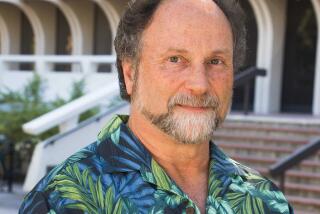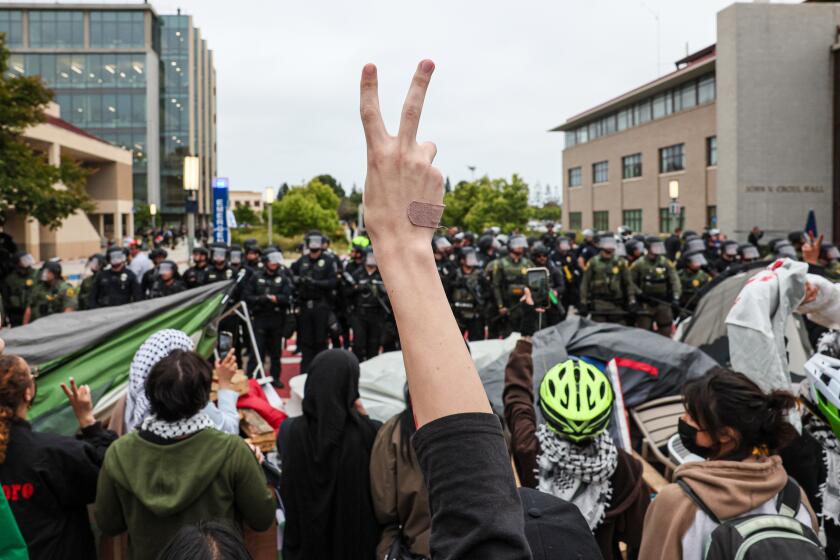Pocket of Paradise : For Three Generations, Life in Gillibrand Canyon Has Been a Family Affair
Five years ago, when Juanita Brooks began planning a massive family reunion at her home in Gillibrand Canyon above Simi Valley, the third-generation Ventura County resident mailed hundreds of invitations to relatives around the globe.
Dozens more family members were easier to reach.
Brooks, 59, simply strolled along the curving road that cuts through the canyon that was named after her pioneer grandfather and knocked on the doors of her cousins, children, nieces and nephews to alert them about the gathering.
“We’ve all lived up here all our lives,” Brooks said. “There’s a beauty and a peace here that keeps us here, makes us realize that there’s no reason to go anywhere else.”
Indeed the sleepy, shaded canyon four miles north of Simi Valley up Tapo Canyon Road is a tiny pocket of rural life locked in a time warp, far from the strip malls and sprawling housing tracts that make up much of Southern California.
There, the Gillibrands ride horses, bale hay, walk barefoot down dusty roads and cross one another’s unfenced lawns, passing through unlocked doors for shared meals and reminiscing.
Of some 20 homes lining the canyon, about 15 belong to Gillibrand offspring.
“When I was a kid and I tried to spend the night at friends’ houses in Simi Valley, I would always have to leave because I felt claustrophobic,” said Melissa Brooks, 39, Juanita Brooks’ daughter. “Here you feel open and free and safe and you’re surrounded by people you love.”
From one home to the next, evidence of the Gillibrand genes abounds in the tall, athletic builds, the large cornflower-blue eyes, the honey-brown hair.
“We all grew up together, so there’s a sense of stability and security,” said Harlene Holeman, 48, a cousin of Brooks’.
When Holeman’s house crumbled in the Jan. 17 earthquake, she found refuge next door with her mother.
“We’ve all got this incredibly strong sense of community and history,” Holeman said. “All we have to do is go down to Simi Valley or Los Angeles to see how lucky we are.”
The legacy of Gillibrand Canyon began with a case of tuberculosis.
Ellen Leyland Gillibrand, Brooks’ grandmother, was diagnosed with TB in 1886, spurring her husband, Edward Clayton Gillibrand, to shut down his silk-spinning shop in Manchester, England, to seek a better climate.
Lured by the promise of adventure and cheap land in the American West, he decided to try his luck as a California cowboy. The Gillibrands sailed into Port Hueneme and headed for the hills, settling on 6,000 acres of prime grazing land north of what is now Simi Valley.
Soon after, Edward Gillibrand made a surprising and lucrative discovery: His land was atop a 12-million-year-old mound of oyster and scallop shells, the largest known deposit of its kind in North America.
The family set about mining the fossilized shells, whose pure calcium content is valued for use in flour, medicine and chicken feed.
Meanwhile, Ellen Gillibrand furnished the ranch house with fine English linens and silks and filled a formal English garden with fragrant, colorful blooms and a flock of peacocks.
A century later the cattle are gone, as are most of the shells. The family property has shrunk to about 1,000 acres, and the old Gillibrand house is just a memory. Having deteriorated over the years, it finally succumbed to the recent earthquake.
All that remains of the elegant garden are several dozen peacocks, who spend their days sunning near the empty, quake-cracked swimming pool and perching in the low branches of centuries-old oaks, their screeches echoing through the quiet canyon.
Family members who work outside the canyon say leaving each day makes them appreciate coming home even more.
“It’s really a refuge,” said Debbie Sandland, 40, a Gillibrand grandchild who serves on the Simi Valley school board.
Her husband, David, 40, agreed.
“I’ve lived all over the place, but this is the best place I’ve ever lived,” he said. “Just a few miles away you’ve got all the freeways and shopping centers you could ever want. Then you come up here and it’s paradise.”
Paradise is not without its problems. The dry hillsides keep the clan on constant watch for brush fires; Juanita Brooks has witnessed 10 especially destructive fires in her lifetime.
Jan. 17 brought another reminder of nature’s mighty force. The Northridge quake sent truck-sized boulders crashing down the canyon walls into three corrals, two barns and a shed.
“It was a mess,” Brooks said. “The cleanup is going to go on for a long time.”
Brooks’ granddaughter, 13-year-old Ashley, has another concern.
“I don’t like being so far away from everything,” she said. “My friends who live in Simi Valley can just walk to shops, but when my mom’s busy and my grandma’s working, I have no ride.”
For the most part, though, Ashley said she enjoys canyon life.
“I have my own horse, and it’s worth it for that,” she said. “I also like being so close to my grandmother and having so much space.”
In that space are many relics of the past, including an old family cemetery--one of the few remaining private graveyards in the state.
“Used to be lots of people had private cemeteries,” Brooks said. “But land got too valuable, so folks dug up the bodies and sold the land.”
The marble headstones and withered bouquets all memorialize Gillibrand relations, save one: A child buried at the site in 1889 is remembered on the marker simply as “Our Neighbor’s Baby.”
Virginia Torgerson, 64, who has lived at the foot of the canyon for 16 years, is not related to the Gillibrands, nor does her family associate much with them.
That’s not a problem, she said.
“That’s part of the beauty of the place,” Torgerson said. “There’s room enough for everyone.”
More to Read
Sign up for Essential California
The most important California stories and recommendations in your inbox every morning.
You may occasionally receive promotional content from the Los Angeles Times.










